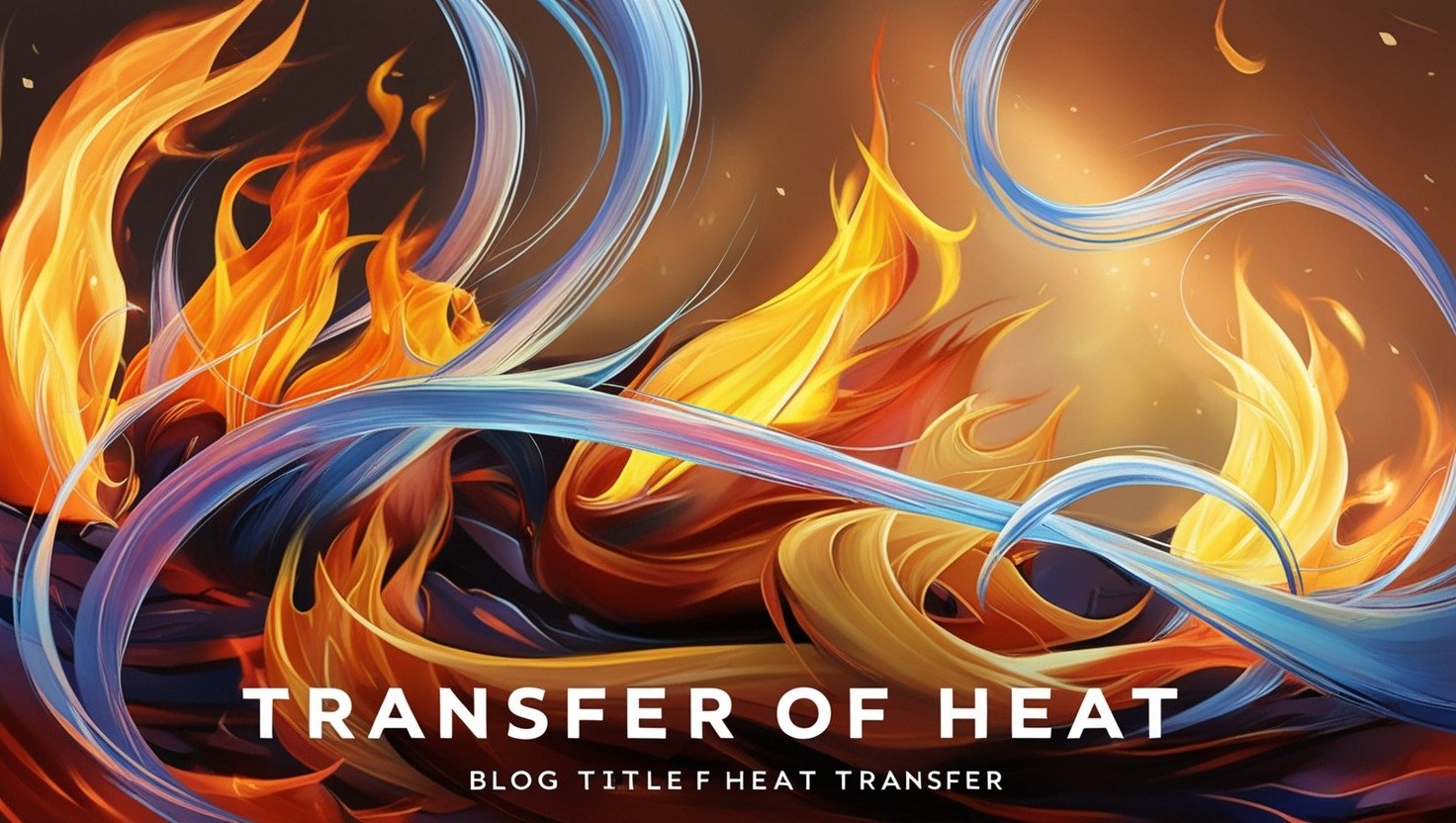Definitions of Heat Transfer:-
Heat transfer is the process by which thermal energy moves from one object or substance to another. It is a fundamental concept in physics and plays a crucial role in various natural and engineered processes.
Understanding how heat transfer works can help explain everyday phenomena, from why metal feels cold to the touch to how the sun warms the Earth.

Modes of Heat transfer:-
There are three primary modes of heat transfer: conduction, convection, and radiation.
Each mode describes a different way that heat can be transferred, and understanding each one is essential for grasping the full picture of thermal energy movement.
Conduction is the transfer of heat through direct contact between materials.
When two objects at different temperatures come into contact, thermal energy moves from the hotter object to the cooler one until they reach the same temperature. A simple example of conduction is when you touch a metal spoon that has been sitting in a hot pot of soup. The heat from the soup transfers to the spoon, making it hot to the touch.
Convection involves the transfer of heat through fluids, which can be either liquids or gases.
This mode of heat transfer occurs when the fluid itself moves, carrying thermal energy with it. An everyday example of convection is boiling water. As water at the bottom of a pot heats up, it becomes less dense and rises, while cooler water descends to take its place. This movement creates a circular flow that evenly distributes heat throughout the water.
Radiation is the transfer of heat through electromagnetic waves, which can travel through a vacuum without the need for a medium. This mode of heat transfer is how the sun’s energy reaches the Earth. Unlike conduction and convection, radiation does not require physical contact or fluid movement. An example of radiation is feeling the warmth of the sun on your skin on a sunny day. The heat travels directly from the sun to your skin through electromagnetic waves.
By understanding these three modes of heat transfer—conduction, convection, and radiation—students can gain a deeper appreciation for the various ways thermal energy moves and affects the world around them.
Good and Bad Conductors of Heat:-
Understanding the properties of materials in relation to heat transfer is essential for various practical applications. Materials that allow heat to pass through them easily are known as good conductors of heat.
Metals such as copper and aluminum are prime examples of good conductors. For instance, copper is widely used in cooking utensils because it allows heat to distribute evenly, ensuring that food cooks uniformly.
On the other hand, materials that do not allow heat to pass through them easily are referred to as bad conductors or insulators. Common insulators include wood, plastic, and rubber. These materials are often used to handle hot objects safely. For example, plastic handles on cooking pots prevent burns by insulating against the heat conducted through the metal pot.
Knowing the difference between conductors and insulators is crucial in many aspects of daily life. In cooking, using a copper or aluminum pan can make a significant difference in how well your meal is prepared.
These metals allow for quick and even heating, making them ideal choices for cookware. Conversely, insulators like rubber and plastic ensure safety and comfort when handling hot items, such as in the grips of tools or the handles of kitchen utensils.
In home insulation, materials that are poor conductors of heat play a vital role in maintaining indoor temperatures. Insulating materials like fiberglass, foam, and even wool are used to keep homes warm in the winter and cool in the summer.
These materials help to reduce energy consumption by minimizing the transfer of heat between the inside and outside of a building.
In summary, the distinction between good and bad conductors of heat is fundamental for both safety and efficiency in everyday tasks. Whether it’s in the kitchen or in home construction, understanding how different materials conduct heat can lead to better choices and improved outcomes.
Heat Transfer in Appliances:
Heat transfer principles play a crucial role in the functioning of many household appliances, including refrigerators, air conditioners, and vacuum cleaners. Understanding how these devices utilize heat transfer can enhance our appreciation of their engineering and functionality.
Refrigerators:-
Refrigerators operate by removing heat from their interior space to keep food and other perishable items cold. This process involves a refrigerant, a special fluid that absorbs heat as it evaporates inside the refrigerator.
The refrigerant is compressed and condensed outside the refrigerator, releasing the absorbed heat into the surrounding environment.

This cycle of evaporation and condensation effectively transfers heat from the inside of the refrigerator to the outside, maintaining a cool internal temperature.
Air Conditioners:-
Air conditioners function similarly by transferring heat from the indoor environment to the outdoors.
An air conditioner draws warm air from inside a room and passes it over evaporator coils filled with refrigerant. The refrigerant absorbs the heat, cooling the air, which is then recirculated back into the room.
The heated refrigerant is compressed and sent to condenser coils located outside the building, where it releases the heat into the external environment. This continuous cycle ensures that the indoor space remains cool during hot weather conditions.
Vacuum Cleaners:-
In vacuum cleaners, heat is generated primarily by the motor as it operates. While heat transfer is less central to their primary function, it is still a consideration in their design.
The motor generates heat as it converts electrical energy into mechanical energy to create suction. To prevent overheating, vacuum cleaners are equipped with ventilation systems and cooling fans that dissipate this heat effectively.
This ensures the appliance remains safe and operational even during extended use.

By understanding how heat transfer principles are applied in these common appliances, students can gain insight into the practical applications of scientific concepts in everyday life. This knowledge not only enhances their comprehension of heat transfer but also fosters a deeper appreciation for the technology that surrounds us.
Ocean Currents and Heat Absorption:-
Ocean currents play a significant role in the Earth’s climate system by distributing heat around the planet. These currents are large-scale movements of seawater driven by various factors, including wind, water density differences, and the Earth’s rotation.
The primary source of energy for ocean currents is the sun, which heats the surface of the ocean unevenly.
This differential heating causes variations in water temperature, leading to the formation of currents that transport warm water from the equator toward the poles and cold water from the poles toward the equator.
Heat absorption is a crucial factor in the behavior of ocean currents. Water, a good absorber of heat, can retain and transport thermal energy over vast distances.
When sunlight strikes the ocean’s surface, it heats the water, causing it to expand and become less dense. Warm water rises, creating a flow toward cooler regions, where it releases its heat and cools down, becoming denser and sinking.
This continuous cycle of heating, rising, cooling, and sinking drives the global conveyor belt of ocean currents.
The efficiency of heat absorption varies depending on the surface’s color. Dark-colored surfaces, such as deep ocean water, are excellent absorbers of heat. These surfaces absorb a significant amount of solar radiation, warming up more quickly and intensely than lighter-colored surfaces.
Conversely, light-colored surfaces, such as ice and snow-covered regions, are poor absorbers of heat. They reflect much of the incoming solar radiation, thereby remaining cooler and contributing less to heat-driven ocean currents.
Understanding how different surfaces absorb heat is essential for grasping the dynamics of ocean currents and their impact on global climate patterns. Illustrations can help visualize these concepts, showing how dark and light surfaces react differently to heat absorption.
For example, a diagram might depict dark ocean water absorbing more heat and warming up faster compared to lighter-colored ice, which reflects sunlight and stays cooler. These visual aids can enhance comprehension of how surface characteristics influence temperature and, consequently, the movement of ocean currents.
Definitions About Understanding Heat Transfer:
How Heat Moves Around Us:-
Have you ever wondered why your coffee gets cold after a few minutes, or how the sun’s warmth reaches us from so far away? It’s all about heat transfer! In this article, we’ll explore the three main ways heat moves around us: conduction, convection, and radiation.
What is Heat Transfer?
Heat transfer is the flow of heat energy from a hotter body to a colder body. It’s like when you hold a hot cup of coffee and feel the warmth spreading to your hands.
Modes of Heat Transfer
There are three main ways heat moves around us:
1. Conduction: When heat moves through direct contact between particles. Example: Holding a hot cup of coffee, the heat travels from the cup to your hands through conduction.

2. Convection: When heat moves through the movement of fluids (like air or water). Example: When you heat up a pot of water, the hot water rises, and cooler water sinks, creating a convection current.

3. Radiation: When heat travels through electromagnetic waves (like light). Example: The sun’s warmth reaches us through radiation, even from millions of miles away!

Everyday Applications
Conduction: Cooking utensils, thermoses, and even your body!
Convection: Ocean currents, weather patterns, and heating systems.
Radiation: Light bulbs, fireplaces, and the sun’s warmth.
Good and Bad Conductors of Heat
Good conductors: Metals like copper, silver, and gold.
Bad conductors: Materials like wood, plastic, and air.
Ocean Currents
Ocean currents are a great example of convection in action! Warm water rises, cools, and sinks, creating a circulation of water that helps regulate Earth’s climate.
Good and Bad Radiators of Heat
Good radiators: Dark-colored objects, like black cars or dark clothing.
Bad radiators: Light-colored objects, like white cars or light clothing.
Good and Bad Absorbers of Heat
Good absorbers: Dark-colored objects.
Bad absorbers: Light-colored objects.
Vacuum Flask
A vacuum flask is a special container that reduces heat transfer through conduction and convection. It keeps drinks hot or cold for hours by creating a vacuum (a space with no air) between the inner and outer walls.

By understanding heat transfer, we can explain how birds can glide for hours (they use rising warm air currents!), identify appliances that use different modes of heat transfer (like refrigerators and ovens), and even list heat-conducting materials in our surroundings (like metal spoons and pans).
In conclusion, heat transfer is an essential part of our daily lives, and understanding its modes and applications can help us appreciate the world around us.
Process of heat transfer in refrigerators and air conditioners:
Refrigerator:

1. Heat Absorption: The refrigerant (a liquid that changes state easily) absorbs heat from the food and air inside the fridge.
2. Compression: The refrigerant is compressed, raising its temperature and pressure.
3. Heat Rejection: The hot refrigerant releases its heat to the outside air through the condenser coils.
4. Expansion: The refrigerant expands, lowering its temperature and pressure.
5. Evaporation: The cold refrigerant evaporates, absorbing heat from the fridge and starting the cycle again.
Air Conditioner:
1. Heat Absorption: The refrigerant absorbs heat from the room air through the evaporator coils.
2. Compression: The refrigerant is compressed, raising its temperature and pressure.
3. Heat Rejection: The hot refrigerant releases its heat to the outside air through the condenser coils.
4. Expansion: The refrigerant expands, lowering its temperature and pressure.
5. Evaporation: The cold refrigerant evaporates, cooling the room air and starting the cycle again.
In both cases, heat is transferred from the colder body (food/fridge or room air) to the hotter body (outside air), allowing for cooling to occur.







Post Comment